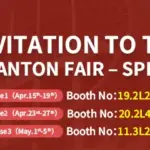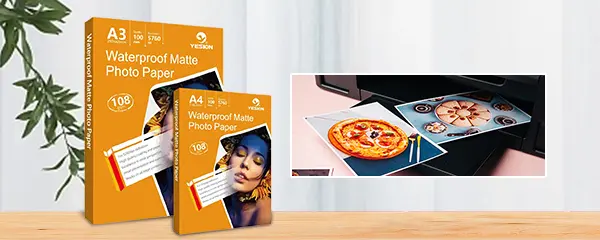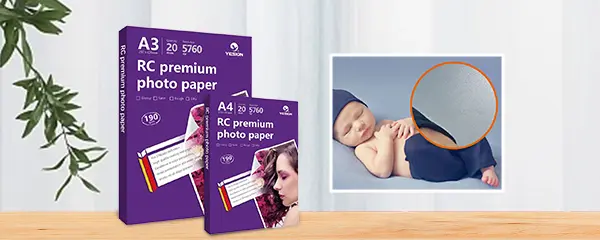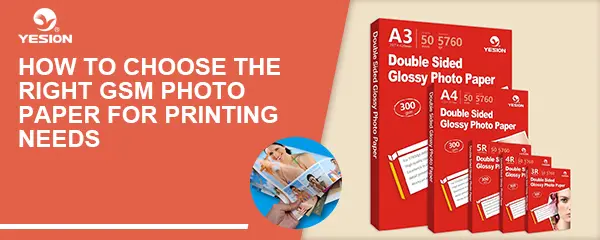
Best Colored Sticker Paper for Crafting & DIY
2025-03-28
Invitation to the 137th Canton Fair – Spring 2025
2025-04-11Choosing the right GSM photo paper is crucial for achieving high-quality prints that meet your specific needs. Whether you are printing professional photographs, promotional materials, or home prints, the GSM of the photo paper affects the durability, thickness, and print quality.
In this guide, we will break down the different types of photo paper, their GSM ranges, and how to choose the best one based on your printing requirements.
What Does GSM Mean in Photo Paper?
GSM (Grams per Square Meter) is a measurement of the paper’s weight and thickness. Higher GSM papers are thicker, more durable, and often used for professional printing, while lower GSM papers are lighter and more suitable for everyday printing.
How GSM Affects Your Prints
Lower GSM (120-180 GSM) → Thinner paper, suitable for standard prints and everyday use;
Medium GSM (200-260 GSM) → Standard photo paper thickness for high-quality prints;
Higher GSM (270-350 GSM) → Heavyweight, professional-grade photo paper for exhibition-quality prints.
Related:
The Weight or Thickness of Inkjet Photo Paper Affects Print Quality
Types of Photo Paper and Their Weight Ranges
1. Glossy Photo Paper (180-300 GSM)
Best for: High-contrast, vibrant color prints.
Features: Shiny, reflective surface that enhances color depth.
Common Uses: Family photos, commercial prints, promotional materials.
Recommended GSM:
180-200 GSM → Light, budget-friendly glossy prints.
230-260 GSM → Standard professional photo quality.
300 GSM+ → Premium glossy prints with enhanced durability.
Related:
The Importance of Choosing the Right Glossy Photo Paper for Printing Photos
2. Matte Photo Paper (120-260 GSM)
Best for: Soft, non-reflective images with a smooth finish.
Features: No glare, fingerprint-resistant, absorbs ink well.
Common Uses: Black-and-white photography, text-heavy images, artistic prints.
Recommended GSM:
120-180 GSM → Lightweight, great for portfolios and presentations.
200-260 GSM → Standard professional matte prints.

matte photo
Related:
Inkjet matte photo paper: 10 things to consider before purchasing
Inkjet Matte Photo Paper: A Guide to Printing Your Best Photos
3. Satin & Luster Photo Paper (200-280 GSM)
Best for: A balance between glossy and matte finishes.
Features: Slight sheen without high reflectivity, good color depth.
Common Uses: Wedding photography, portraits, professional photo albums.
Recommended GSM:
200-240 GSM → Everyday premium prints.
250-280 GSM → High-quality professional prints.

satin photo
Related:
RC Rough Satin Photo Paper
4. Fine Art & Textured Photo Paper (250-350 GSM)
Best for: Museum-grade prints and artistic photography.
Features: Textured surface, acid-free for long-lasting archival prints.
Common Uses: Gallery prints, high-end photography, artistic reproductions.
Recommended GSM:
250-280 GSM → Premium textured paper.
300-350 GSM → Exhibition-grade prints.
How to choose photo paper?
1. Consider Your Printing Purpose
Everyday Prints & Home Use → 120-180 GSM.
Professional Photography & High-Quality Prints → 200-300 GSM.
Gallery & Exhibition Prints → 300-350 GSM.
2. Match Paper GSM with Printer Compatibility
Some inkjet and laser printers have specific GSM limits.
Check your printer’s recommended paper weight before choosing photo paper.
3. Think About Print Longevity
Higher GSM papers resist wear and tear better and are ideal for long-term preservation.
For archival-quality prints, choose acid-free, high GSM fine art paper.
4. Consider Handling and Storage Needs
Glossy papers (high GSM) are prone to fingerprints but offer vibrant colors.
Matte and luster papers (mid to high GSM) are smudge-resistant and better for handling.
Choosing the right weight of photo paper depends on your printing purpose, desired finish, and printer compatibility. For high-quality, professional photo paper, explore the selection at Yesion Photo Paper Solutions.
Related:
Is satin photo paper the same as matte?
Discover the Beauty of Photo Paper

